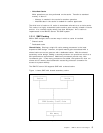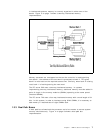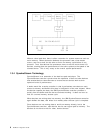performance. (Please see 1.3, “Memory” on page 3 for a discussion of memory
speeds and system performance.) The point is that you cannot compare system
performance by simply looking at the speed at which the processor is running.
A 90 MHz machine with a set of matched components can out perform a 100
MHz machine which is running with slow memory. IBM PC Servers are always
optimized to incorporate these factors and they always deliver a balanced
design.
1.1.2 External Interfaces
The processor data interface, or data bus, is the data connection between the
processor and external logic components. The Pentium family of processors
utilizes a 64-bit data bus, which means that they are capable of reading in 8
bytes of data in one memory cycle from processor main memory. The Intel 486
has a data bus of only 32-bits, which limits its memory cycles to 4 bytes of data
per cycle.
The width of the processor address interface, or address bus, determines the
amount of physical memory the processor can address. A processor with a
24-bit address bus, such as the i286 class of processors, can address a
maximum of 16 megabytes (MB) of physical memory. Starting with the i386 class
of processors, the address bus was increased to 32 bits, which correlates to 4
gigabyte (GB) of addressability.
1.1.3 Processor Types
IBM currently uses two processors in the PC Server line:
•
80486DX2
The 80486DX2 has a 32-bit address bus and 32-bit data bus. It utilizes clock
doubling to run at 50/25 MHz or 66/33 MHz. It is software compatible with all
previous Intel processors. The 80486DX2 has an internal two-way set
associative 8KB cache.
•
Pentium
The Pentium has a 32-bit address bus and 64-bit data bus. It has internal
split data and instruction caches of 8KB each. The instruction cache is a
write-through cache and the data cache is a write-back design. The Pentium
microprocessor is a two-issue superscalar machine. This means that there
are two integer execution units (ALUs) in addition to the on-board floating
point unit. The superscalar architecture is one of the key techniques used to
improve performance over that of the previous generation i486 class
processors. Intel was able to achieve this design while maintaining
compatibility with applications written for the Intel i368/i486 family of
processors.
Note: A superscalar architecture is one where the microprocessor has
multiple execution units, which allow it to perform multiple operations during
the same clock cycle.
2 NetWare Integration Guide


















